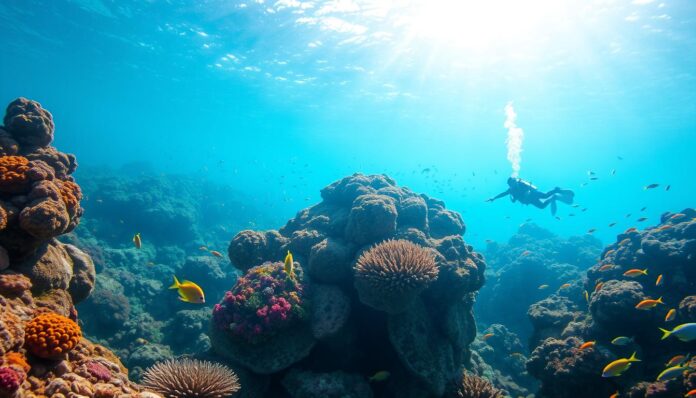| Best Time to Travel | May-October |
| What to Expect | Warm water, clear visibility, diverse marine life |
| Diving Conditions | Year-round, but best from May-October |
| Marine Life | Whale sharks, manta rays, turtles, sharks, dolphins, fish |
Are you ready to find the most untouched underwater paradise? Madagascar offers an amazing Scuba Diving in Madagascar experience. It will change how you see marine exploration.
Madagascar is the fourth largest island and has a unique marine ecosystem. It has 80% of its species found nowhere else on Earth. This tropical wonderland promises divers an unmatched underwater adventure in pristine waters full of extraordinary marine life.
Underwater Exploration Madagascar shows stunning landscapes with vibrant coral reefs. These reefs stretch from 3 to 14 meters deep. Divers can dive into crystal-clear waters with visibility up to 50 meters. They will see rare marine species dancing in colorful underwater environments.
Key Takeaways – Scuba Diving in Madagascar
- Madagascar offers unique marine biodiversity with 80% endemic species
- Diving visibility can reach an impressive 50 meters
- Diving depths range from 3 to 14 meters
- Best diving season spans April to January
- Encounters with rare marine life guaranteed
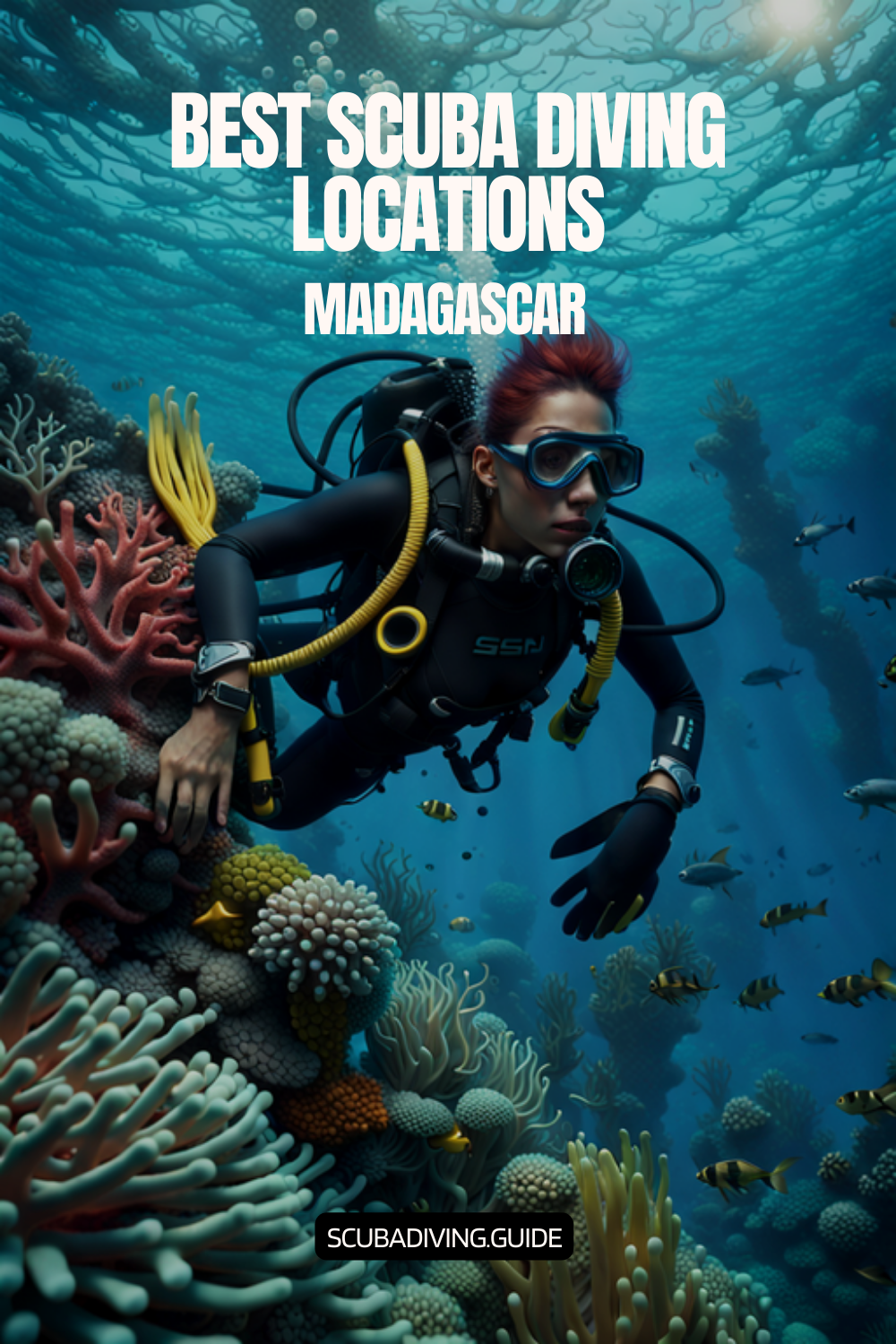
Introduction to Scuba Diving in Madagascar
Madagascar is a paradise for scuba diving, attracting divers from all over. Its unique Marine Life Madagascar offers a diving experience like no other. The clear waters around this hotspot are home to unexplored marine ecosystems.
Why Choose Madagascar for Diving?
Dive Sites Madagascar show off incredible underwater landscapes. The island’s marine life is unlike anywhere else, thanks to its unique features:
- Approximately 90% of marine species are unique to Madagascar
- Over 1,500 different fish species inhabit these waters
- More than 500 coral species create vibrant underwater ecosystems
Unique Marine Biodiversity
Madagascar’s marine world is full of life. Divers can see:
- 34 different whale and dolphin species
- 56 shark species
- 5 sea turtle species
“Madagascar’s underwater world is a living museum of marine life, providing unmatched diving experiences.”
Best Time to Dive
The best time to dive is from April to December. During this time, divers can enjoy:
- Water temperatures between 25°C and 30°C
- Visibility often exceeding 30 meters
- Opportunities to observe seasonal marine migrations
Pro tip: Avoid the cyclone season from January to March when most dive stores are closed.
Top Diving Destinations in Madagascar
Madagascar is a paradise for scuba diving, with its rich marine life and stunning dive sites. The island’s unique location offers incredible opportunities for underwater exploration. You can dive in many amazing places.
The marine life in Madagascar is incredibly diverse. You can see 34 whale and dolphin species, 56 shark types, and 1,300 reef fish species. Divers will have unforgettable underwater experiences.
Nosy Be: The Diving Jewel
Nosy Be is the top spot for diving in Madagascar. It’s known for its clear waters and rich marine life. The dive sites here offer amazing encounters with marine creatures.
- Crystal-clear waters with visibility up to 50 meters
- Water temperatures ranging from 25°C to 28°C
- Home to diverse marine ecosystems
Toliara: Southern Marine Wonderland
Toliara is another great diving spot in Madagascar. It has unique underwater landscapes and impressive coral formations. The marine habitats here are diverse.
Anakao: Untouched Underwater Realm
Anakao lets divers explore untouched marine environments. It’s known for its pristine conditions and rich marine life.
| Diving Destination | Key Features | Best Season |
|---|---|---|
| Nosy Be | Highest marine biodiversity | June-September |
| Toliara | Unique coral formations | May-December |
| Anakao | Pristine underwater landscapes | June-September |
“Madagascar’s underwater world is a hidden treasure waiting to be explored by passionate divers.” – Marine Exploration Magazine
These dive sites are just a small part of Madagascar’s underwater wonders. They promise unforgettable experiences for all scuba diving enthusiasts.
Marine Life Encountered While Diving
Madagascar’s underwater world is amazing. It attracts divers from all over. The marine life here is incredible, with many species and colorful ecosystems.
Stunning Corals and Reefs
Madagascar’s marine landscape is full of coral diversity with 300 species. These reefs are home to many marine life forms. Divers see a world of colors and textures that make Madagascar’s marine life special.
Famous Species: Manta Rays and Whale Sharks
Madagascar is great for diving with whale sharks. It’s home to many marine animals, including:
- 56 types of sharks
- 34 whale and dolphin species
- 5 turtle species
Diving with manta rays is also a highlight. Whale sharks are seen in Nosy Be from October to November. Manta rays are around from April to mid-July and again from mid-September to November.
“The underwater world of Madagascar is a living canvas of marine biodiversity.” – Marine Conservation Expert
Macro Diving: Tiny Wonders Underwater
Madagascar’s waters are also home to tiny wonders. With over 1,300 bony fish species, macro divers can see the details of small creatures. These tiny beings are often overlooked.
| Marine Life Category | Species Count |
|---|---|
| Hard Coral Species | 300 |
| Shark Species | 56 |
| Whale and Dolphin Species | 34 |
| Turtle Species | 5 |
| Bony Fish Species | 1,300 |
Diving Conditions and Safety
Scuba Diving in Madagascar offers amazing underwater experiences. The marine environment is unique and perfect for both new and experienced divers. It’s a place where unforgettable underwater adventures await.
Water Temperature and Visibility
Madagascar’s diving conditions are inviting and consistent. The water temperature stays between 25°C and 29°C, making diving comfortable all season. Visibility is impressive, ranging from 15-30 meters, with the best clarity from May to October.
| Season | Water Temperature | Visibility Range |
|---|---|---|
| Dry Season (April-October) | 26-29°C | 20-30 meters |
| Wet Season (November-March) | 25-27°C | 15-20 meters |
Diving Regulations and Certifications
PADI Courses Madagascar are available for all divers. It’s recommended to have:
- Open Water Diver certification
- Advanced Open Water certification
- Rescue Diver qualification
Safety Tips for Divers
Keeping safety first is key for an amazing dive. Here are some tips:
- Always dive with a certified professional
- Check equipment before each dive
- Maintain proper hydration
- Follow local diving guidelines
“Respect the ocean, and it will reveal its most incredible secrets.” – Madagascar Diving Experts
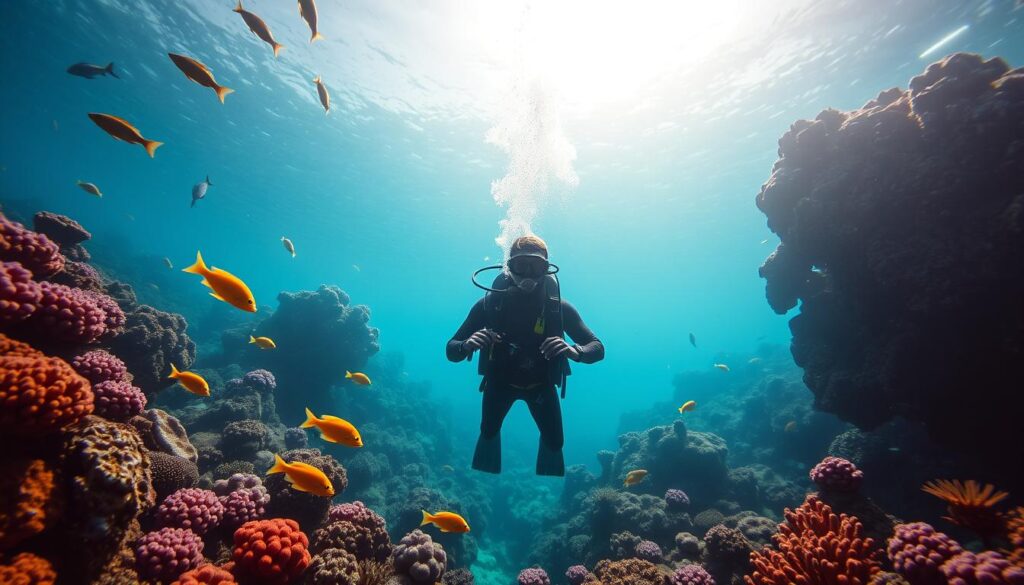
Divers can explore Madagascar’s marine environments safely. Understanding local conditions and following safety protocols is essential.
Diving Tours and Operators
Madagascar is a top spot for diving. It offers many diving experiences. You can take PADI Courses Madagascar or go on a liveaboard adventure.
Recommended Diving Schools
Looking to dive better? Professional PADI Courses Madagascar are available. Key schools in the area offer great training:
- Blue Dive Madagascar – Located in Nosy Be
- Octopus Diving Center – Specializing in certification courses
- Tropical Marine Diving School – Offers advanced training
Guided Dive Tours
Guided dive tours offer a special look at Madagascar’s sea life. Local guides make sure you have a safe and fun dive. They show you the best spots and help you through the reefs.
Liveaboard Experiences
Liveaboard Diving Madagascar is the best way to see the sea. These trips last a few days and take you to amazing places. You’ll dive in beautiful waters and stay in comfy places.
“Liveaboard diving in Madagascar offers an unparalleled journey through some of the world’s most untouched marine landscapes.” – Marine Exploration Magazine
Liveaboard trips usually last 3-7 days. They give you a full diving experience without the hassle of traveling.
Protecting Madagascar’s Marine Ecosystem
Coral Reef Diving Madagascar is more than an adventure. It’s a chance to help protect marine life. The island’s underwater world is facing big challenges, with ecosystems changing a lot.
Madagascar’s marine world is under a lot of pressure. Recent numbers show some scary trends:
- Fish catch per Vezo fisherman has dropped by 46% from 2015
- Illegal fishing costs the region $143 million each year
- Ocean temperatures are rising, threatening marine habitats
Importance of Conservation in Diving
Exploring Madagascar’s underwater world is not just about seeing amazing sea creatures. It’s also about protecting fragile ecosystems. Divers are key in keeping these delicate underwater places safe.
Initiatives for Marine Protection
Several important conservation efforts are making a big difference:
- Setting up Marine Protected Areas (MPAs)
- Checking coral health with Coral Watch
- Starting community-based conservation projects
How Divers Can Help
“Every dive is an opportunity to become a marine conservation ambassador”
Divers can help by:
- Practicing safe diving techniques
- Joining underwater clean-up efforts
- Supporting local conservation groups
- Choosing eco-friendly dive operators
By following these steps, divers can help protect Madagascar’s unique marine world for the future.
Beginner-Friendly Diving Options
Diving in Madagascar is a great chance for beginners to see the underwater world. PADI Courses Madagascar are perfect for those starting their scuba diving journey. They help discover the marine wonders of this unique place.
New divers can start their underwater adventure in Madagascar with confidence. The island has many beginner options for those new to scuba diving.
Introductory Courses for New Divers
Dive centers in Madagascar offer detailed beginner courses for all skill levels. You can choose from:
- Discover Scuba Diving programs
- PADI Open Water Certification
- Introductory shallow water lessons
Best Sites for Beginners
Madagascar has several dive spots perfect for beginners. They offer amazing marine experiences:
- Nosy Komba: Easy to reach, just 20 minutes from Nosy Be
- Tanikely National Marine Park: Has protected waters with great visibility
- Sainte-Marie Island: Great for new divers and snorkelers
FAQs for New Divers
“No prior diving experience? No problem! Madagascar welcomes divers of all skill levels.”
Beginners often ask:
- What equipment do I need?
- How much do courses cost?
- Is it safe for first-time divers?
Dive experiences start at $2,859 for a 5-day tour. Dive centers like Oceane’s Dream can handle up to 30 divers. This ensures beginners get the attention they need.
The best diving time is October to January. This is when whale sharks are around, making it a memorable experience for new divers.
Advanced Diving Opportunities
Madagascar is a paradise for experienced divers. It offers unique marine adventures and challenging dive sites. These sites are perfect for advanced divers who want to test their skills and see incredible underwater landscapes.
Technical Diving Options
For those who love technical diving, Madagascar has a lot to offer. It has deep-water environments and specialized underwater experiences. Dive Sites Madagascar provide many options for technical certification and exploration:
- Deep dive training at depths ranging from 30-40 meters
- Advanced buoyancy control techniques
- Nitrox and mixed gas diving
- Specialized night diving experiences
Remarkable Wreck Diving Sites
Madagascar’s maritime history is preserved in its underwater wrecks. The southern region is home to famous shipwrecks like the Winterton and Nossa Senhora do Carmo. These wrecks give divers a chance to learn about historical maritime stories.
“Every wreck tells a story, and Madagascar’s underwater museums are waiting to be explored by adventurous divers.” – Marine Exploration Magazine
Diving Challenges in Madagascar
Exploring Madagascar’s underwater world requires advanced skills and preparation. Divers will face challenges such as:
- Drift diving along complex current systems
- Deep-water navigation
- Marine ecosystem interaction
- Limited visibility in certain areas
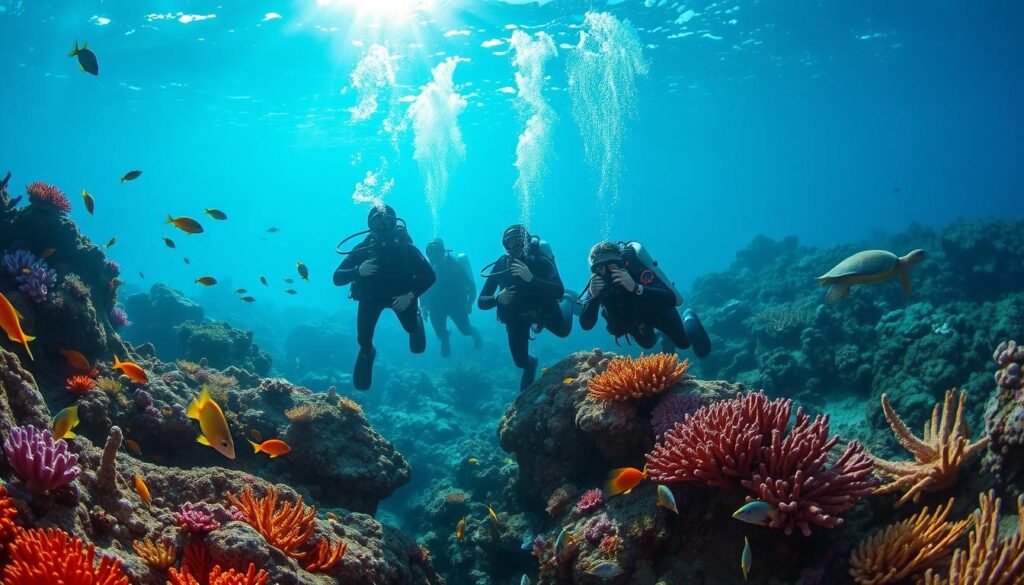
With over 20 dive sites and depths from 12 to 40 meters, Madagascar offers an unmatched advanced diving experience. It’s a place where divers can truly explore the wonders of the marine world.
Best Gear for Scuba Diving in Madagascar
Getting ready for diving in Madagascar means picking the right gear. The right equipment can make your diving experience amazing.
Essential Equipment Checklist
Here’s what you need for your underwater adventure:
- Lightweight 3mm wetsuit (Madagascar’s warm waters are perfect)
- Mask with anti-fog coating
- Reliable dive computer (Shearwater Perdix 2 recommended)
- Underwater camera for marine life documentation
- Reef-safe sunscreen
Recommended Rental Options
Travelers can rent gear in Madagascar to save space. The Cressi Big Eyes Evolution snorkel mask and Mares Avanti Quattro Plus fins are great choices. They fit different body types and diving styles.
Smart Gear Purchasing Tips
Buying diving gear for Madagascar? Follow these tips:
- Choose lightweight, tropical-appropriate gear
- Prioritize durability and comfort
- Select equipment from brands like APEKS and Cressi
- Invest in quality regulators like APEKS XTX50
“The right gear transforms an ordinary dive into an extraordinary underwater exploration.” – Marine Expedition Experts
Equipment costs vary from R 285 per dive to R 1,220 for night diving gear. Eco-friendly divers might like Waterlust’s gear made from recycled plastic bottles.
Cultural Aspects of Diving in Madagascar
Diving in Madagascar is more than just exploring the sea. The island’s rich culture adds a special touch to diving. It connects travelers with local traditions and communities.
Local Traditions and Community Involvement
Madagascar is home to 18 ethnic groups, each with its own view of the sea. Coastal communities are key in keeping the marine life safe:
- Small group tours help local guides earn a living
- Traditional fishing helps in saving the sea
- Local groups protect the underwater world
Diving Etiquette and Cultural Respect
It’s important to respect local customs while diving in Madagascar. Divers should:
- Learn basic Malagasy greetings
- Support local businesses
- Know and respect fady (local taboos)
“In Madagascar, diving is not just an activity, but a cultural exchange.” – Local Marine Conservation Expert
Engaging with Conservation Efforts
Divers can help protect the sea by:
- Joining beach clean-ups
- Helping in marine research
- Attending workshops with coastal communities
By understanding the culture, divers make connections that go beyond the sea.
Preparing for Your Dive Trip
Planning a trip to explore Madagascar’s underwater world is exciting. Scuba diving here offers amazing sights. But, you need to prepare well to stay safe, comfortable, and have great underwater experiences.
Travel Requirements and Visa Information
Madagascar makes it easy for visitors to enter. You’ll need a visa, which costs about $27. You can buy it when you arrive. Make sure your passport is good for at least six months after your trip.
- Passport validity: Minimum 6 months beyond travel dates
- Visa cost: Around $27 USD
- Payment method: Local currency (ariary)
Health and Safety Precautions
Staying healthy is key for a great dive trip. Talk to a doctor before you go. They can:
- Check if you’re fit for diving
- Recommend vaccinations
- Tell you how to avoid malaria
“Preparation is the key to a safe and enjoyable diving adventure.” – Professional Diving Experts
Packing List for Divers
Make a detailed list for your dive trip to Madagascar. Include:
- Diving certification cards
- Travel insurance documents
- Dive-specific equipment
- Personal first aid kit
- Prescription medications
Use packing cubes to save space and keep things organized. Also, check your airline’s baggage rules to avoid extra fees.
Final Preparation Tips
Before you leave for Madagascar, remember these important tips:
- Make sure you have good travel insurance
- Bring extra copies of important papers
- Find out about local hospitals near where you’ll dive
- Choose light, quick-drying clothes
With good planning, your dive trip to Madagascar will be unforgettable. You’ll explore the beauty of the underwater world.
Underwater Photography in Madagascar
Diving into the world of Marine Life Madagascar offers photographers an extraordinary underwater exploration opportunity. Digital photography advancements have transformed underwater imaging, enabling divers to capture stunning marine scenes instantly. Nosy Be, situated between the Radama and Mitsio archipelagos, presents exceptional photographic environments for marine enthusiasts.
Professional photographers find remarkable diversity in Madagascar’s marine ecosystems. Macro photography techniques excel in this region, with reduced water turbidity allowing crystal-clear images of tiny marine creatures. Divers regularly encounter fascinating subjects like seahorses, leaf fish, ghost pipefish, and hawkfish. Rare species such as Rhinopias occasionally appear, creating exceptional photographic moments during Underwater Exploration Madagascar.
Camera equipment plays a critical role in capturing marine memories. Professional photographers recommend Canon (G11, G12, G16), Olympus (Pen-PL7), and Sony video cameras for different underwater scenarios. Dive center staff are experienced in handling advanced photographic gear, ensuring photographers receive technical support during their marine adventures.
The key to successful underwater photography lies in understanding marine ecosystems. By shifting focus from large marine creatures to tiny, often overlooked critters, photographers can reveal Madagascar’s hidden underwater wonders. Specialized photography dives in Nosy Be cater to various interests, from macro close-ups to wide-angle landscape shots of vibrant marine environments.
Tips for Capturing Marine Life
When photographing Marine Life Madagascar, patience and respect for underwater habitats are essential. Use natural lighting, minimize camera movements, and maintain a safe distance from marine creatures to capture authentic, undisturbed moments.
Recommended Equipment for Photographers
Select waterproof cameras with manual settings, wide-angle and macro lenses, and reliable underwater housing. Brands like Canon, Olympus, and Sony offer excellent options for Underwater Exploration Madagascar.
Ethical Photography Practices
Prioritize marine conservation by avoiding direct contact with marine life, respecting underwater ecosystems, and sharing images that promote environmental awareness and protection.
Madagascar Recommended Scuba Diving Itinerary
Embarking on a scuba diving adventure in Madagascar calls for a well-planned itinerary to make the most of the country’s diverse and captivating underwater world. Here’s a recommended scuba diving itinerary that showcases some of the must-visit dive sites and highlights the best of Madagascar’s marine biodiversity.
Day 1-3: Nosy Be
Begin your diving journey in Nosy Be, a popular diving destination known for its pristine waters and abundant marine life. Start with warm-up dives in the calm and colorful reefs near the island, where you can encounter an array of tropical fish, including angelfish, butterflyfish, and triggerfish. Explore sites like Coral Garden, where vibrant coral formations and swaying sea fans create a picturesque underwater landscape. Don’t miss the chance to dive at “The Aquarium” in Nosy Tanikely Marine Reserve, where you’ll be surrounded by a kaleidoscope of marine species.
Day 4-6: Tulear
Next, head to Tulear on Madagascar’s southwest coast, where the Tulear Barrier Reef awaits. Dive into the crystal-clear waters to discover breathtaking coral gardens, swim-throughs, and dramatic drop-offs. Encounter schools of colorful reef fish, as well as larger species like Napoleon wrasses and humphead parrotfish. Explore sites such as Madiorano, famous for its stunning coral pinnacles, and Anakao, where you may encounter turtles, eagle rays, and even whale sharks during the right season.
Day 7-9: Ile Sainte-Marie
Travel east to Ile Sainte-Marie, a picturesque island known for its historical significance and captivating dive sites. Dive the “Dofa” wreck, a sunken cargo ship that has become a thriving artificial reef, attracting a variety of marine life. Explore the surrounding reefs and encounter manta rays, whale sharks, and vibrant schools of fish. Ile Sainte-Marie offers a mix of diving experiences, from exploring shallow coral gardens to venturing into deeper waters where you might spot reef sharks and barracudas.
Day 10-12: Nosy Mitsio
Continue your adventure by heading north to Nosy Mitsio, a remote and untouched diving destination. This region boasts pristine coral reefs, impressive rock formations, and encounters with pelagic species. Dive along dramatic walls and explore underwater caves adorned with colorful soft corals. Keep an eye out for barracudas, trevallies, and possibly even dolphins. The seclusion and tranquility of Nosy Mitsio provide a unique diving experience away from the crowds.
Day 13-15: Radama Islands
Conclude your diving itinerary in the enchanting Radama Islands, northwest of Madagascar. Immerse yourself in the turquoise waters surrounding the islands, teeming with marine life. Dive the coral-covered pinnacles, drift along vibrant reefs, and explore intriguing canyons. Encounter turtles, rays, and schools of tropical fish that thrive in this untouched underwater paradise. Take time to relax on the pristine white-sand beaches and soak in the breathtaking views of the surrounding archipelago.
This scuba diving itinerary in Madagascar offers a diverse range of underwater experiences, from vibrant coral gardens to thrilling encounters with pelagic species. Remember to check the best diving seasons for each region to ensure optimal conditions and maximize your chances of encountering specific marine life.
Please note that this itinerary can be customized based on your preferences, available time, and the specific dive sites you wish to explore. It is advisable to consult with local dive operators and experts who can provide up-to-date information and tailor the itinerary to your needs.
As you plan your scuba diving adventure in Madagascar, get ready to embark on an unforgettable journey into the depths of the Indian Ocean, where a world of underwater wonders awaits you.
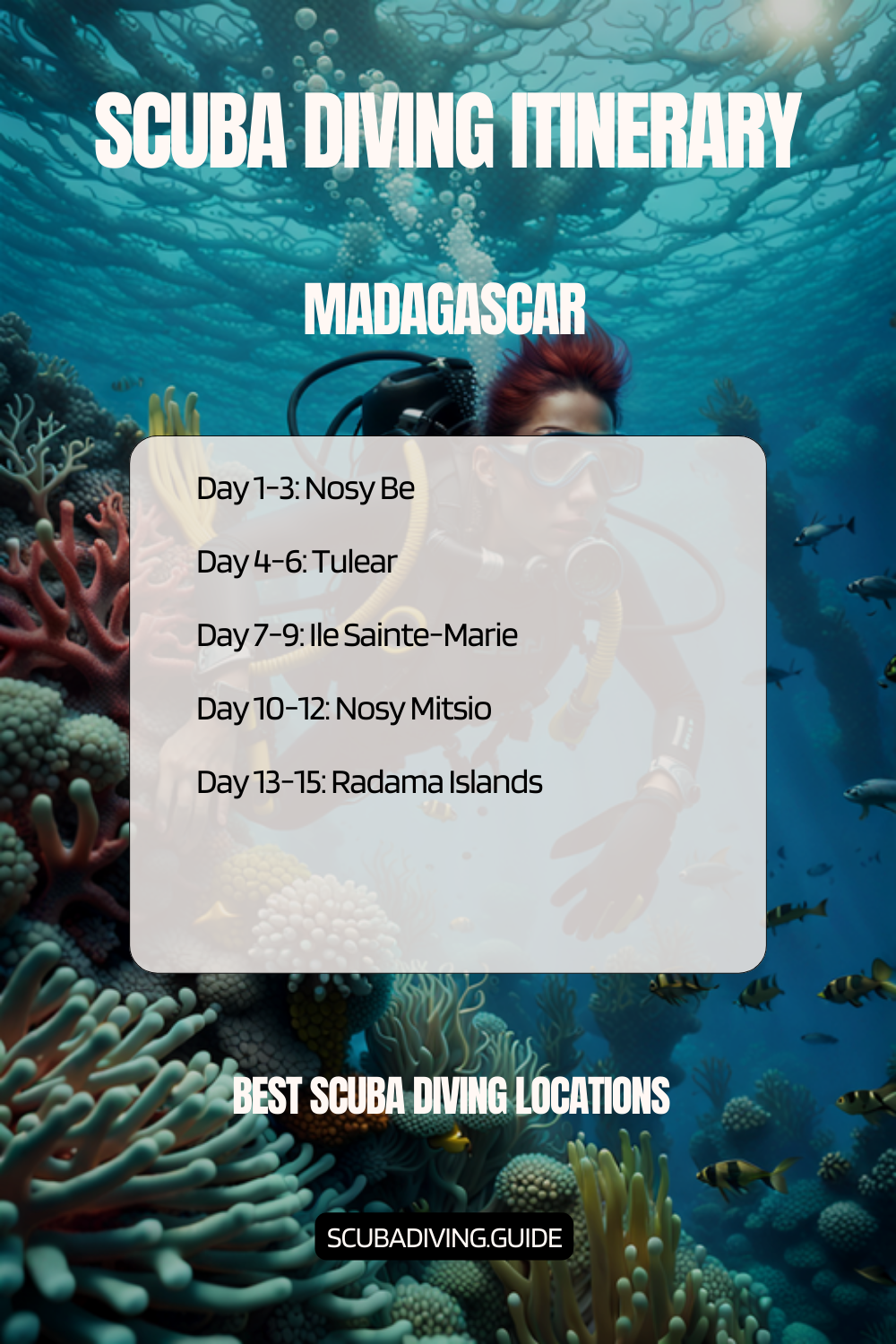
Other Countries to Consider
FAQ – Scuba Diving in Madagascar
What is the best time of year to go scuba diving in Madagascar?
The best time to dive in Madagascar is from May to December. This period has the best diving conditions. From January to March, the cyclone season makes diving less ideal.
Do I need a specific diving certification to dive in Madagascar?
While not always needed, a PADI certification is recommended. Many dive operators prefer divers with at least an Open Water certification. Beginners can take introductory courses at dive centers, like those in Nosy Be.
What marine life can I expect to see while diving in Madagascar?
Madagascar’s waters are home to whale sharks, manta rays, and humpback whales (September to November). The coral reefs are also great for spotting unique, tiny marine creatures.
How much does diving in Madagascar cost?
Diving costs vary by location and dive type. Single dives cost between $30 to $60, with discounts for multiple dives. Liveaboard experiences cost $150-$300 per day, including diving packages.
Is Madagascar safe for scuba diving?
Madagascar is safe for diving, with warm waters and clear visibility. Always follow safety guidelines and dive with reputable operators. Make sure you have the right insurance.
What equipment should I bring for diving in Madagascar?
A thin 3mm wetsuit is enough due to the warm waters. Bring your mask, dive computer, and spare parts. Many dive centers offer rentals, but personal gear is more comfortable.
Are there diving options for beginners in Madagascar?
Yes! Madagascar has great sites for beginners, with calm waters and shallow reefs. Dive centers offer courses and guided tours for new divers.
What conservation efforts can divers support in Madagascar?
Divers can help by choosing eco-friendly operators and participating in clean-ups. Respect marine life and support local conservation projects. Many organizations protect Madagascar’s marine ecosystems.
Do I need a visa to dive in Madagascar?
Yes, all nationalities need visas, available upon arrival for about $27. Make sure your passport is valid for at least six months after your stay.
What are the top diving destinations in Madagascar?
Nosy Be is the top spot, followed by Toliara and Anakao. These places offer diverse marine life, stunning reefs, and chances to see whale sharks and manta rays.
